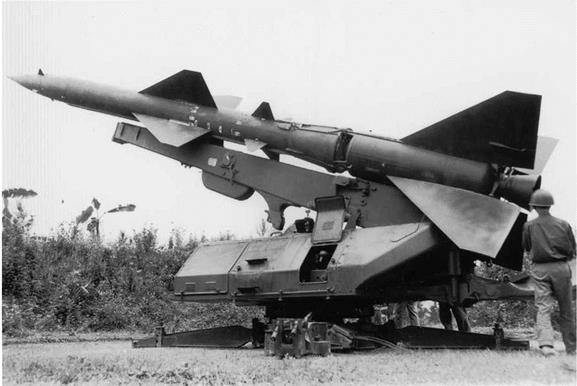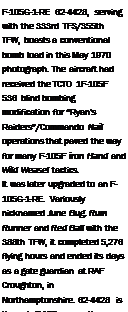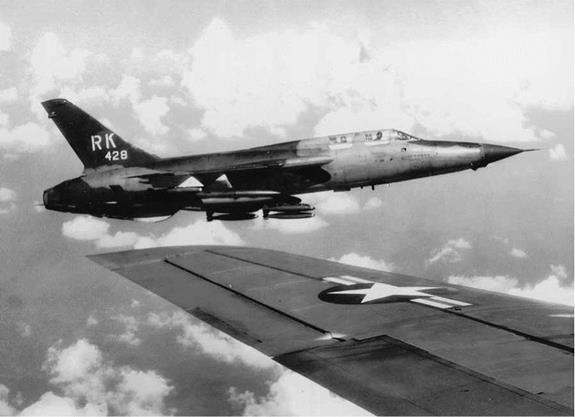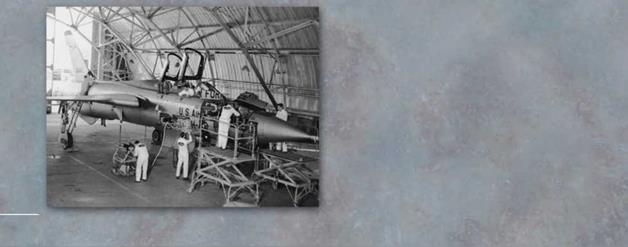INTRODUCTION
Pyotr Grushin, who headed the OKB-2 design bureau that conceived the V-750/ SA-2 in 1953, would have been surprised that “his” missile was used in Vietnam primarily against tactical fighters. Its original purpose was to intercept high-flying American bombers equipped with nuclear weapons, as Premier Joseph Stalin had considered them to be the biggest threat to the USSR. Only at the conclusion of the Vietnam War was it pitted against the B-52 Stratofortress, the opponent that had motivated Grushin’s team 20 years earlier.
Similarly, Alexander Kartveli, a Russian emigrant from Stalin’s hometown, Tbilisi, and primary designer of the F-105 Thunderchief nuclear strike fighter in 1952, could hardly have guessed that his creation would evolve into the USAF’s first dedicated aircraft for the suppression of enemy air defenses (SEAD), particularly the SA-2, over North Vietnam.
Suppressing anti-aircraft fire was an established mission for tactical aircraft, and its dangers were well known. In support of the massive airborne assault codenamed Operation Market Garden in September 1944, four USAAF fighter groups attacked German flak batteries and the 56th FG lost a third of its P-47 Thunderbolts on one mission alone. This role continued through the Korean War and into Vietnam, where anti-aircraft artillery (AAA) was the largest component in the communist North’s air defense network. Dueling with flak gunners was risky, officially discouraged, but sometimes inevitable.
![]() The introduction of surface-to-air missiles (SAMs) in the early 1950s demanded new approaches. Radar-directed missiles were seen as the replacement for air-to-air guns, being the nemesis of both manned fighters and bombers. Tests indicated that their probability-of-kill rate was close to 100 per cent even with unreliable thermionic valve technology that existed at the time. The loss of a Lockheed U-2 spyplane over
The introduction of surface-to-air missiles (SAMs) in the early 1950s demanded new approaches. Radar-directed missiles were seen as the replacement for air-to-air guns, being the nemesis of both manned fighters and bombers. Tests indicated that their probability-of-kill rate was close to 100 per cent even with unreliable thermionic valve technology that existed at the time. The loss of a Lockheed U-2 spyplane over

the USSR in May 1960 and another over Cuba in October 1962 showed the accuracy of the SA-2 and the difficulties in defeating it. Ten years later, America’s foremost military aircraft were still being destroyed by the same missile over North Vietnam.
In Korea, the USAF was unprepared for the radar-directed AAA which threatened its B-29 bombers, forcing it to resort to World War Il-vintage radar jammers and B-26 Invaders fitted with radar homing. In 1953 the American military responded to the advent of the SA-2 with the funding of urgent electronic warfare research, although fitting SAM warning systems to aircraft like the U-2 still had a low priority.
The Cuban missile threat hastened the development of the Texas Instruments ASM-N-10 (later designated AGM-45 Shrike) as a US Navy anti-radiation missile (ARM) in 1962—64, although it did not appear on USAF aircraft until March 1966. The Bendix Corporation responded quickly to the arrival of SA-2s around Hanoi with a Radar Homing and Warning (RHAW) system proposal for the F-100 Super Sabre that used existing, tested equipment.
By August 1965, after USAF jets began to fall to SA-2s, Brig Gen Kenneth Dempster was tasked with energising the anti-SAM program and finding rapid, operationally practical solutions. His committee recommended a force of hunter-killer aircraft to extend Korean War tactics by using SAM radar detection equipment to identify SA-2 sites rather than merely jamming them.
For Project Wild Weasell, four F-100F Super Sabres carried two systems produced by Applied Technologies — the Vector IV (APR-25) RHAW set with a cathode ray tube strobe showing the direction of a SAM threat, and the IR-133 panoramic receiver which analysed and identified radar emissions. Finally, a WR-300 unit warned of an imminent SAM launch.
As Wild Weasel pioneers, Maj Garry Willard and his four-aircraft F-100F Detachment interrupted their training at Nellis AFB due to the urgent need (as seen by the Pentagon) for “an immediate RHAW capability to counter the missile threat” and headed to Korat Royal Thai Air Force Base (RTAFB). Commencing operations on November 24, 1965, the “det” quickly established many of the tactics used by later F-105F/G crews, including the standard SAM evasion tactic — a “split-S” diving turn into the missile’s trajectory, with a last-second break that the missile could not follow. Capts Allen Lamb and Jack Donovan made the first of nine SAM-site kills on December 22, 1965, attacking and marking the target with guns and LAU-3 rocket pods for F-105D bombers. Lamb recalled, “As I pulled off there was a bright flash. I must have hit the oxidizer supply for the SA-2 rocket motor”.
![]()
 |
 |
This engagement introduced a new era of electronic warfare between the crews of the F-100F’s successor, the F-105 Thunderchief, and teams of North Vietnamese conscripts and their Soviet advisors. Operating in hot, dark, claustrophobic radar vans, the missile technicians sat close together on simple metal chairs, grappling with the crude but tricky manual control wheels of “Fan Song” guidance radars and learning to penetrate US jamming and countermeasures. They faced the constant risk of an anti-radiation missile strike on their compartment, or a lacerating cluster-bomb attack. Other troops drove the SA-2’s cumbersome trans-loader vehicles from the SAM sites into crowded urban areas to collect new missiles once the SAM battery’s complement of 12 weapons was exhausted.
In the cockpits of the small numbers of F-105 Wild Weasels, pilots struggled to steer their heavy aircraft through unprecedented levels of AAA, not to mention multiple SA-2 launches, trying in poor visibility to identify camouflaged SAM sites and set up missile attacks on them. Their electronic warfare officers (EWOs, or “bears”) faced an increasing overload of work as they managed the EW systems and weapons panels. They also had to watch for MiGs, despite the very limited view from their cockpits, and monitor crowded communications and navigation channels, while enduring constant high-g maneuvering. Their mission was neatly summarized in the 388th TFW’s Tactics Manual:
The mission of Wild Weasel aircrews generally falls into two roles — Iron Hand to suppress and Wild Weasel to destroy. Tactics employed on the Iron Hand missions are primarily designed to suppress the SA-2 and gun-laying radar defenses of North Vietnam during the ingress, attack and egress of the main strike force. Shrike missiles are used to kill, or at least harass, the SA-2 and/or “Fire Can” (AAA) radar transmitters. Coincidentally the threat represented by the Iron Hand flight also diverts the attention of enemy radar operators from the main strike force and this, in itself, is a form of suppression.
 On both sides, courage and ingenuity were at least as important as technology.
On both sides, courage and ingenuity were at least as important as technology.
![]()
|

|












